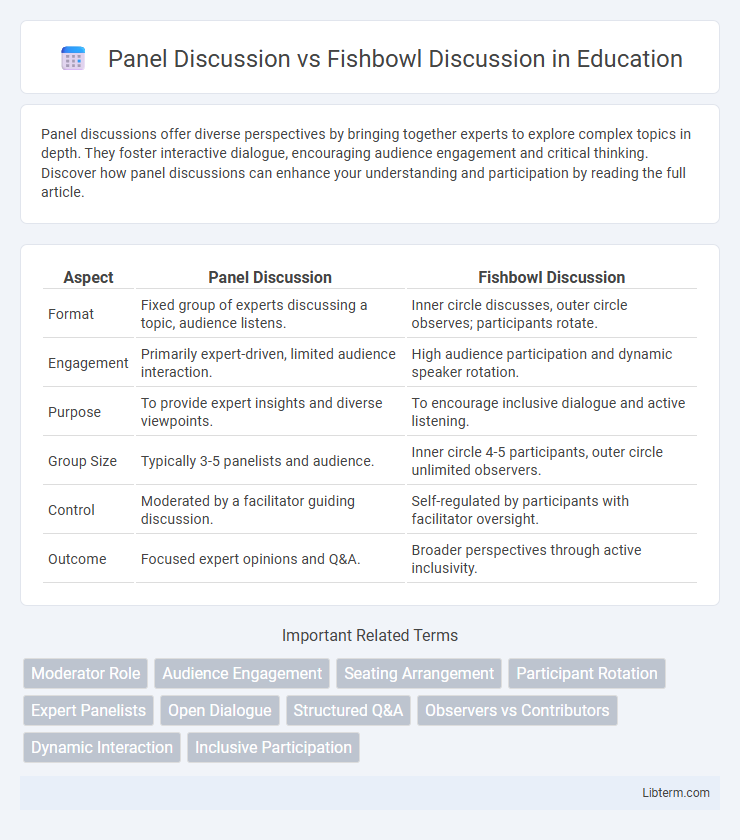Panel discussions offer diverse perspectives by bringing together experts to explore complex topics in depth. They foster interactive dialogue, encouraging audience engagement and critical thinking. Discover how panel discussions can enhance your understanding and participation by reading the full article.
Table of Comparison
| Aspect | Panel Discussion | Fishbowl Discussion |
|---|---|---|
| Format | Fixed group of experts discussing a topic, audience listens. | Inner circle discusses, outer circle observes; participants rotate. |
| Engagement | Primarily expert-driven, limited audience interaction. | High audience participation and dynamic speaker rotation. |
| Purpose | To provide expert insights and diverse viewpoints. | To encourage inclusive dialogue and active listening. |
| Group Size | Typically 3-5 panelists and audience. | Inner circle 4-5 participants, outer circle unlimited observers. |
| Control | Moderated by a facilitator guiding discussion. | Self-regulated by participants with facilitator oversight. |
| Outcome | Focused expert opinions and Q&A. | Broader perspectives through active inclusivity. |
Introduction to Panel and Fishbowl Discussions
Panel discussions feature a group of experts who share insights on a specific topic while engaging with audience questions, promoting a structured yet interactive format. Fishbowl discussions create an inclusive environment where a small inner circle of participants actively debates, and outer circle members listen and can join in by replacing someone inside. Both formats enhance collaborative knowledge exchange but differ in interaction dynamics and participant roles.
Defining the Panel Discussion Format
The panel discussion format involves a structured conversation where a group of experts shares insights on a specific topic in front of an audience, often guided by a moderator to ensure balanced participation and timely progression. Participants typically take turns responding to questions, fostering a diverse range of perspectives while maintaining a formal setting. This format emphasizes expert knowledge delivery and controlled interaction over audience-driven dialogue.
Understanding the Fishbowl Discussion Method
Fishbowl Discussion is an interactive dialogue format where a few participants sit in a circle ("fishbowl") while others observe, allowing dynamic exchanges and seamless participant rotation to foster deeper engagement and diverse viewpoints. Unlike traditional Panel Discussions, which feature a fixed group of experts addressing an audience, Fishbowl Discussions emphasize inclusivity and spontaneous contributions from observers, promoting democratic conversation flow and collective meaning-making. This method enhances active listening, critical thinking, and collaborative problem-solving in group settings by breaking hierarchical communication barriers.
Key Differences Between Panel and Fishbowl Discussions
Panel discussions feature a group of experts seated in front of an audience who listen and occasionally ask questions, emphasizing a formal structure and expert insights. Fishbowl discussions involve a smaller group actively engaging in conversation within an inner circle, while the larger audience observes silently, promoting dynamic interaction and inclusive participation. The key difference lies in participants' roles: panel discussions prioritize expert presentations, whereas fishbowl discussions encourage collaborative dialogue and equal speaking opportunities.
Advantages of Panel Discussions
Panel discussions offer structured expert insights, allowing diverse viewpoints to be presented and debated efficiently within a set timeframe. They foster authoritative knowledge sharing by featuring seasoned professionals who provide credible information and thoughtful analysis. Audience members benefit from the clarity and depth of responses, making panel discussions effective for exploring complex topics comprehensively.
Benefits of Fishbowl Discussions
Fishbowl discussions foster active engagement by allowing participants to dynamically enter and exit the conversation, promoting diverse perspectives and deeper understanding. This format encourages equal participation, reducing dominance by a few voices, which enhances inclusivity and democratizes dialogue. The transparent seating arrangement in fishbowl setups improves focus and accountability, making the discussion more interactive and responsive.
When to Choose a Panel Discussion
Choose a panel discussion when seeking expert insights on complex topics, enabling multiple specialists to present diverse perspectives in a structured format. It is ideal for large audiences requiring clear, concise information from authoritative voices to facilitate understanding and decision-making. Panel discussions excel in scenarios demanding in-depth analysis, expert credibility, and time-efficient delivery of varied viewpoints.
When to Opt for a Fishbowl Discussion
Fishbowl discussions excel when fostering inclusive engagement in large groups, allowing a rotating inner circle to actively participate while others observe, which differs from the fixed expert panel format. Opt for a fishbowl when the goal is to surface diverse perspectives dynamically, encourage audience interaction, and break hierarchical communication. This format is particularly effective for topics requiring collective sense-making and real-time shifts in viewpoints.
Engaging the Audience: Panel vs Fishbowl
Panel discussions typically feature a fixed set of experts conversing on a topic, with audience engagement limited to Q&A sessions, which can restrict active participation. Fishbowl discussions enhance audience involvement by allowing attendees to join the inner circle, creating a dynamic exchange that blurs the line between speakers and listeners. This format fosters deeper interaction and real-time feedback, making it highly effective for collaborative learning and diverse perspectives.
Which Discussion Format is Best for Your Event?
Panel discussions feature a fixed group of experts sharing insights, ideal for delivering structured information to large audiences. Fishbowl discussions promote dynamic, inclusive conversations by rotating participants between an inner and outer circle, fostering diverse viewpoints and engagement in smaller settings. Choosing the best format depends on your event goals: panels suit authoritative, topic-focused sessions, while fishbowls excel in interactive, participatory environments.
Panel Discussion Infographic

 libterm.com
libterm.com